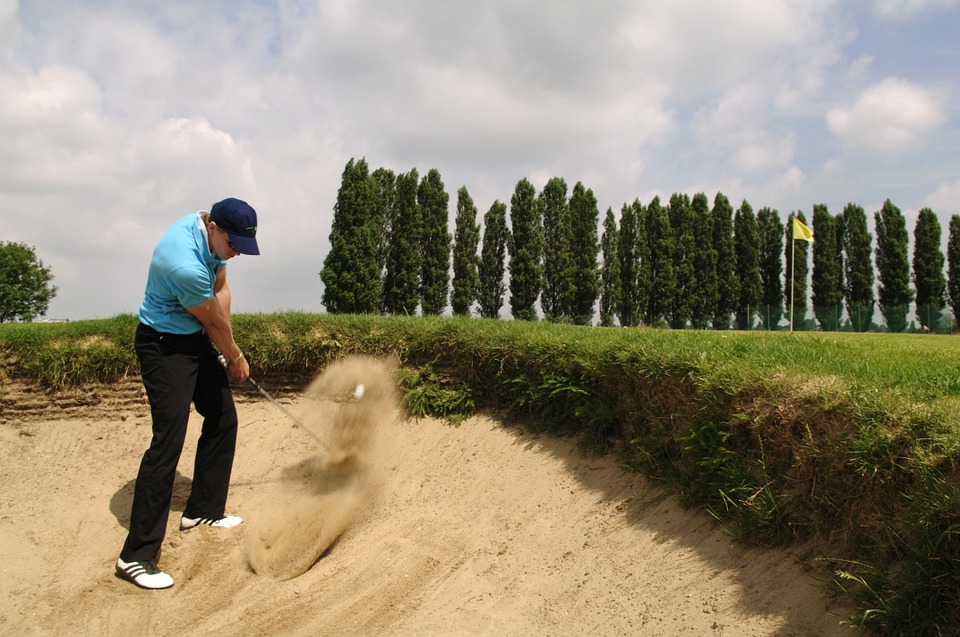Bunkers have a long history in the game of golf. Also known casually as a “trap” (but don’t say that to a Rules official!), bunkers are one of two types of hazard on the green (the other being water hazards). The origin of both the sand bunker and the water hazard come from the Scottish roots of the game, as the early courses were set on links land in coastal areas. The location of these historical courses meant that wind would blow sand into the course, where it would collect in depressions and mound against ridges naturally.
The water hazards on these links lands were formed by rain runoff and rivers flowing towards the sea. While only 17 percent of golf courses in Scotland are true “links” courses, they are some of the oldest courses with the most history.
As more people developed courses for play, these naturally-occurring hazards began to be built into the game in the places where they would not happen on their own, as they change the way that golfers play the game entirely. Today, the Rules of Golf govern the specific rules for how to play balls that fall into a hazard.
The types of bunkers: Fairway bunkers are traditionally located along the sides of -or in the middle of- the fairway, and are developed with the idea of catching tee shots that go awry. Greenside bunkers are located around the green, and are used to gather the long shots that miss. Waste bunkers are the larger sandy areas that naturally occur on courses that are in the coastal links grounds as described above, and as these are usually not architect-designed to influence play, have a few more allowances for golfers than other types of bunkers. Grass bunkers are not technically bunkers, as they are not a “hazard” in the rules. Grass bunkers are really more akin to a rough.
With the advances in technology and design for balls and clubs that players use, not all fairway bunkers come into play like they used to, and older courses may see hazards failing to present a challenge to lower-handicapped players, and penalizing those players that have a higher handicap. Course management may want to consider updating bunkers to keep games challenging.
Courses with poorly-constructed bunkers can cause many problems for the superintendent as well as the players. Flat bunkers may lack drainage, causing costly maintenance as well as undesirable playing conditions. No one wants to wade into a sand-puddle for their ball.
Flashed bunker faces are steep sand faces that almost look like cliffs, which provide an architectural and aesthetic appeal, but can erode and expose the soil underneath, contaminating the bunker.
Bunker condition is one of the top concerns of club members and players worldwide.
Golf Course Industry online speaks to the number of bunker-reconstruction that has been occurring in the last few years. Often, reconstructing bunkers can be cheaper over time than maintenance and upkeep on courses that have struggling bunkers.
For years bunkers were lined with cloth before being filled with sand, but these textile liners can become exposed with erosion, tear when caught by mechanical rakes, or even be pulled up by animals.
A new technology in bunkers that many are employing, including GreatLife KC, is system of using a layer of pea gravel, which is then sprayed with a polymer and left to cure. Once set, this polymer bonds the gravel/grit together so that it is rigid, but remains permeable to water. Then white sand is installed and compacted over the gravel. With the right sand, this method minimizes or even eliminates sand movement, and erosion leading to sand contamination is minimal, as the gravel stays firmly in place. While this system is more costly than some other alternatives, the longevity and ease of upkeep should pay for itself over time.
For those in charge of maintaining courses, consider if your bunkers meet player requirements for a good game as well as quality requirements to keep your costs at a minimum. Is it time to reconstruct your bunkers?
For those in charge of playing on courses, check out Golf Digest’s article on how the pros make bunkers look so easy, for tips to try out the next time you end up in a hazard yourself!

